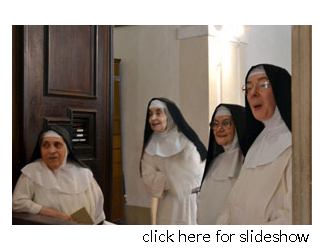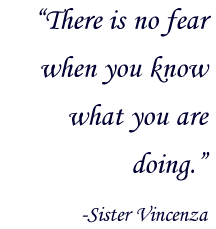The Nuns of Cagli
By Jael Cooper
They bob and weave in the doorway, crowding around the simple wooden frame like a flock of seagulls. They are eager to communicate with visitors. Their gowns sway slightly as they rhythmically move their hands and covered heads in conversation. 
These women of Cagli, Italy, wore white on their wedding days, stood before God, and donned gold bands. When they are not greeting visitors at their door or consoling the woe-begotten from behind a lattice of ironwork, they maintain a home, tend a garden, and feed chickens. Despite sounding like many of the women of Cagli, these four go by “sorella” or sister instead of signora, spending their days and nights as sequestered nuns at the Monastero Domenicano.
The convent as it functions today was established in 1915, yet the stone walls and large wooden door that separate the sisters from the outside world was first inhabited in 1529. According to the convent’s literature, the Bishop of Cagli, Monsignor Cristoforo Del Monte, founded the church that Benedictine nuns called home until the bubonic plague brought an end to their order in Cagli. The building stood empty from 1749 until 1914, at which time it was converted into a school. The following year, the sisters of the Monastero Domenicano were brought in, and although the school no longer exists, the nuns stayed.
Mother Rosaria stands quietly and watches over the conversation from behind a pair of thick-lensed glasses. She arrived at the convent at age 15 and has been there for 60 years, longer than the other three women. Though she says little, Mother Rosaria’s mere presence brings solemnity to the occasion. She was elected as the convent’s second in command through a system of voting with black-and-white beans. She seems unaffected by her higher status, but the others clearly see her as the society’s nucleus. Through simple words and with a steady gaze, she guides the nuns as they carry on the tradition of the Monastero Domenicano: caring for the souls of those who need them most.
In contrast to Mother Rosaria, Sister Anna is vibrant. At 29, she realized her desire to care for the souls of the Cagliesi through her devotion to God. When she articulates the life choice she made decades earlier, she describes her decision as having answered a deep calling in her heart.
While Sister Anna speaks, another white-robed and black-veiled figure moves slowly on the outskirts of the group. The twinkle in her eyes betrays a playful soul. Like Sister Anna, Sister Agnese came to the convent later in life. At the age of 22, she came upon the Monastero Domenicano and describes the feeling as having been “slain in spirit.” For her, Sister Agnese says, “to find this place was a miracle.”
 While these two sisters may be lively, they need only turn to the right to find a more relaxed companion. Sister Vincenza, a native of Cagli, embodies the laidback philosophy that seems to guide life on this town’s piazza. As she moves between states of serenity and chattiness, her gestures remain fluid yet strong. Leaning against the doorframe, she dismisses any notions of fear about committing to a life behind stone walls at the age of 15. “There is no fear,” she says, straightening to her full height, “when you know what you are doing.”
While these two sisters may be lively, they need only turn to the right to find a more relaxed companion. Sister Vincenza, a native of Cagli, embodies the laidback philosophy that seems to guide life on this town’s piazza. As she moves between states of serenity and chattiness, her gestures remain fluid yet strong. Leaning against the doorframe, she dismisses any notions of fear about committing to a life behind stone walls at the age of 15. “There is no fear,” she says, straightening to her full height, “when you know what you are doing.”
Hearing the six o’clock bells, the four begin to disengage from the conversation. Before shutting the two large, wooden doors, they come to the same consensus: to be a nun is simply “the happiest way to be.” With that, the hinges let out a long, low sigh, and the sound of swishing skirts grows muffled as four women glide across cool stone floors to reflect on God’s grace.
Adventure with Us!








